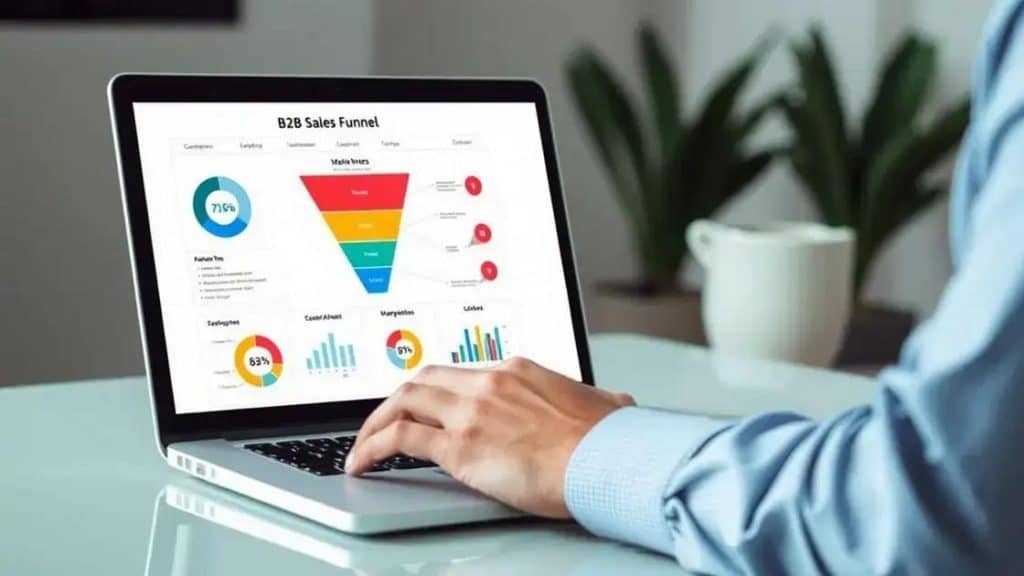B2B sales outreach methods that actually get results

B2B sales outreach involves strategies to connect with other businesses for selling products or services, emphasizing audience research, personalized communication, and leveraging technology to enhance effectiveness and measure success through key metrics.
B2B sales outreach methods play a crucial role in connecting businesses with potential clients. Have you ever wondered which techniques truly make a difference in your outreach efforts? Let’s dive into effective strategies that can elevate your sales game.
Understanding B2B sales outreach
Understanding B2B sales outreach is essential for any business looking to succeed. It involves the strategies used to reach out to potential clients in a way that captures their interest. By leveraging effective outreach methods, companies can create connections that lead to valuable partnerships and sales.
What is B2B Sales Outreach?
B2B sales outreach refers to the process of contacting other businesses to sell products or services. It often encompasses various methods, including email, phone calls, and social media interactions. The goal is to initiate a conversation and convert leads into customers.
Key Components of Effective Outreach
There are several components that make outreach successful:
- Research: Understanding your target audience is vital. Know their needs and pain points.
- Personalization: Tailoring your messages can significantly increase engagement. Use the recipient’s name and reference their business challenges.
- Follow-Up: Consistent follow-up demonstrates your interest and dedication, which can set you apart from competitors.
- Value Proposition: Clearly communicate the benefits of your product or service. Explain how it can solve their problems.
When you combine these elements, your outreach efforts can be much more effective. The landscape of B2B sales is competitive, and understanding how to stand out is key.
Moreover, utilizing technology can streamline and enhance these outreach efforts. Tools such as customer relationship management (CRM) systems can help track interactions and measure success. This allows businesses to optimize their strategies and focus on what works best.
Ultimately, understanding B2B sales outreach means knowing how to connect with other businesses authentically. Creating a genuine relationship can lead to lasting success.
Key strategies for effective outreach
Key strategies for effective outreach are essential for making connections in the world of B2B sales outreach. These strategies help you to engage potential clients and stand out from the competition. Each approach brings unique benefits that can enhance your sales efforts.
Research Your Audience
Before reaching out, it’s crucial to research your audience. This allows you to understand their needs and pain points. Knowing what challenges they face can help you tailor your message.
Personalize Your Communication
Generic outreach often falls flat. Instead, focus on personalizing your communication. Using the recipient’s name and referencing their specific business needs can grab their attention.
- Address Pain Points: Identify how your product can solve their issues.
- Be Genuine: Show authenticity in your outreach.
- Engage with Value: Provide useful insights or information in your messages.
Valuing the relationship over a quick sale can foster trust, making your outreach efforts more effective. Moreover, consider the timing of your outreach. Contacting potential clients at the right moment can greatly affect their interest level.
Utilize Multiple Channels
Effective outreach often means using multiple channels. Don’t rely solely on one method of communication. Combining email, social media, and even phone calls can maximize your reach. Each channel has its strengths, and diversifying your approach can increase your chances of success.
Moreover, tracking your outreach efforts can be instrumental. By measuring the effectiveness of different strategies, you can refine your methods and focus on what yields the best results. Constant evaluation ensures that your outreach remains relevant and effective in a changing market.
How to personalize your outreach

Learning how to personalize your outreach can significantly impact your B2B sales outreach. Personalization helps establish a connection and makes your message stand out. By understanding your audience better, you can tailor your approach to fit their unique needs.
Know Your Audience
The first step in personalizing outreach is knowing who you are talking to. Researching the company and its decision-makers is crucial. Look at their industry, recent news, and challenges they might be facing.
Use Personalized Messaging
After gathering information, develop personalized messages. Instead of sending a generic email, refer to specific details about their company. Mention achievements or recent changes that relate to your offering.
- Include Their Name: Always address contacts by their first name to create a personal touch.
- Reference Past Interactions: If you’ve communicated before, mention previous topics to show you remember.
- Pinpoint Pain Points: Talk about how your solution can alleviate their specific issues.
This kind of personalization shows that you value them as an individual and helps build trust. Furthermore, using tools like CRM software can assist you in managing this information seamlessly.
Follow Up Thoughtfully
Don’t forget the importance of follow-ups. Personalized follow-ups can be just as impactful as the initial outreach. Send them additional relevant information or resources that could benefit their business. This demonstrates that you genuinely care about their needs and are willing to support them even before a sale.
Overall, by personalizing your outreach, you enhance your chances of making a meaningful connection. It not only increases engagement but also builds long-term relationships that drive sales.
Leveraging technology in outreach
Leveraging technology in outreach is a critical step in enhancing your B2B sales outreach. By utilizing various tools and platforms, businesses can streamline their communication efforts and improve their overall effectiveness. Technology offers practical solutions to common challenges faced during outreach.
Use CRM Systems
Customer Relationship Management (CRM) systems are invaluable in organizing and managing your outreach efforts. A CRM allows you to track interactions with potential clients, store important information, and analyze data trends.
- Centralized Information: Keep all customer data in one place for easy access.
- Automated Follow-Ups: Schedule reminders for follow-ups so you never miss a chance to connect.
- Performance Analytics: Measure the success of your outreach strategies through analytical reports.
By using a CRM, businesses can enhance their efficiency and ensure no lead is forgotten.
Utilize Social Media Tools
Social media platforms are powerful for outreach. Utilizing tools that manage your social media interactions can broaden your reach and create meaningful connections. By automating some of the outreach processes, you can save time while maintaining a personal touch.
Using social media allows you to engage with potential clients where they already spend their time. This creates organic opportunities for conversations and builds rapport.
Implement Email Marketing Software
Email marketing software can help you design, send, and track email campaigns effectively. You can segment your audience based on their interests and tailor messages to resonate more with them. Automated email sequences can nurture leads throughout the sales funnel.
Moreover, analyzing open rates and click-through rates offers insights into what works. This data helps you refine your approach and make necessary adjustments.
Measuring the success of outreach efforts
Measuring the success of outreach efforts is essential in the world of B2B sales outreach. It allows businesses to understand what strategies work best and where improvements are necessary. By tracking key metrics, companies can make informed decisions that drive better results.
Key Metrics to Track
Several important metrics can help gauge the effectiveness of your outreach:
- Open Rates: This shows the percentage of recipients who opened your emails.
- Response Rates: Measure how many people replied to your outreach efforts.
- Conversion Rates: Track how many leads turned into actual sales.
- Engagement Metrics: Analyze clicks, downloads, or interactions with your content.
Tracking these metrics over time provides valuable insights. This data helps identify trends and patterns that influence your outreach success.
Using Analytics Tools
Integrating analytics tools can simplify the process of measuring success. Tools like Google Analytics and CRM reporting features allow you to collect data efficiently. You can set specific goals and monitor your progress over time.
These tools enable you to analyze customer behavior and understand which outreach methods lead to better engagement. This information is crucial in refining your strategies.
Adjusting Based on Data
Once you have gathered the data, it’s vital to adjust your outreach strategies. If a specific campaign shows low open rates, consider re-evaluating your subject line or targeting. By being flexible and responsive to the data, you can constantly improve your outreach.
Ultimately, measuring the success of your outreach efforts allows you to invest time and resources effectively. It ensures that your team focuses on what truly drives results.
FAQ – Frequently Asked Questions about B2B Sales Outreach
What is B2B sales outreach?
B2B sales outreach refers to the strategies and methods used to connect with other businesses to sell products or services.
How can I personalize my outreach effectively?
You can personalize your outreach by researching your audience and tailoring your messages to address their specific needs and pain points.
What tools can help with B2B sales outreach?
Tools like CRM systems, email marketing software, and analytics platforms can help manage and optimize outreach efforts.
How do I measure the success of my outreach efforts?
You can measure success by tracking metrics such as open rates, response rates, conversion rates, and overall engagement.





